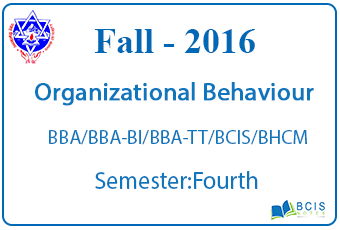
Fundamentals of Organizational Behaviour – Fall, 2016
This is the question set along with answers Fundamental of Organizational Behaviour Fall 2016, which was taken by the Pokhara University.
Pokhara University – Fundamental of Organizational Behaviour Fall 2016
| Level: Bachelor | Semester –Fall | Year: 2016 |
| Program: BBA/BI/TT/BCIS/BHCM | Full Marks: 100 | |
| Course: Fundamentals of Organizational Behaviour | Pass Marks: 45 | |
| Time: 3hrs. | ||
Section “A”
Very Short Answer Questions
Attempt all the questions.
1. What do you mean by organizational behavior?
2. Write down three components of attitudes with examples.
3. What do you understand by learning?
4. Point out five steps in behavior modification.
5. State any four reasons why people join in the group.
6. Sketch the diagram of a self-managed team.
7. Define motivation with its three components.
8. Sketch the diagram of the Communication process model.
9. Differentiate between functional and dysfunctional organizational conflict.
10. Point out any four causes of individual resistance to change.
Section “B”
Descriptive Answer Questions
Attempt any six questions.
11. What are the emerging trends in the field of OB? Discuss major issues confronting managers associated with these trends?
12. Explain major personality traits influencing OB. Why organization must match the job and individual personalities? Justify.
13. What is Group? Differentiate formal and informal groups. Explain the significance of informal groups in organizations.
14. Compare and contrast Maslow’s needs theory and Herzberg’s two-factor theory of motivation. Also, point out the areas of application of the two-factor theory of motivation in an organization.
15. Discuss emerging issues in motivation and leadership.
16. What do you understand by organizational conflict? What approaches would you make to handle organizational conflict?
17. What kinds of barriers may occur during communication? Explain the methods of improving the effectiveness of communication.
Section “C”
Case Analysis
18. Read the scenario and answer the question that follows.
FEAR ABOUT FUTURE
30 employees in Kathmandu Municipality are engaged in recording and filing information, writing complaints, receiving and sending emails. There are increasing complaints from different stakeholders that the Municipality has failed in its service to them. Especially, complaints are noticed in the areas of poor information and communication system within the organization and from different wards of the Municipality.
A reputed Development Agency based in Nepal is interested to offer 100 computers in the first phase of the organizational change program to ensure smooth information management of the municipality. But this offer is not shared by the employees working as the service providers. Upon hearing such news many employees believe that computer will eat their jobs so they will be nowhere in the future. They arranged a few meetings with the Executive Officer and threatened to stop their work if he decides to bring the computers to replace their jobs. The situation became very tense and this information was also shared by the Development Agency. In a joint meeting with representatives of employees, municipality, and Development Agency, a long discussion was made. The Agency is convinced that there is a need to computerize the information system of the Municipality and the Executive is prepared to implement the goal of the Development Agency. However, employees are still scared of the possibility of unemployment. However, they postponed their meetings for the next week.
On a sunny morning of Sunday, the three parties again sat to resolve the crises. After hearing the discussion between municipality authority and employees, the development agency understood the issues and promises to offer some more things for employees. The employee became more satisfied and started to work without any fear about the future.
Questions
a) Describe the main issues of this case?
b) What are the forces behind the change in the Municipality?
c) If you are offered to make the above change, what approach would you follow to change the Municipality?
d) What might have the Agency told to employees so they started to work without any fear of the future?
If you liked our content Fundamentals of Organizational Behaviour || Fall, 2016 then, you may also like Financial Accounting I || Spring, 2016 || Pokhara University || BBA/BBA-BI/BBA-TT/BCIS/BHCM

Leave a Reply